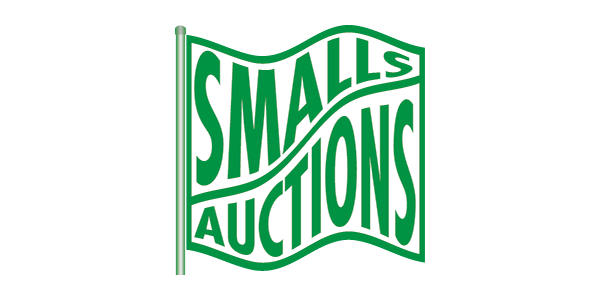Auction 143 Highlights
Welcome to Smalls Auctions No.143
In this auction we have exciting offerings of Australian Banknotes, Colonial Silverware, Tribal Artefacts, Jewellery and Militaria.
The auction starts with two example of mounted Emu Eggs which were a derivative of the mounted Ostrich Eggs so popular in the grand house of Mother England. The best example is the lidded goblet with gilded interior which was the work of jeweller William Edwards. Englishman Edwards had arrived in Melbourne in July 1857 and set up his first workshop at 129 Collins Street. He advertised his special skills of making 'sacrament services to order - Tea and Coffee sets (of) any design - Emu Eggs mounted - Race Cups (of) all sizes and design'. Edwards was considered a leading silversmith of his day and he submitted works to the 1861 International Exhibition and the 1866 International Colonial Exhibition held in Melbourne.
The South Australian Banking Company £1 signed and issued in 1862 is a classic rarity of Australia’s Colonial period. The bank had its genesis in the Bank of South Australia which was set up in in London in 1837 to service the employees of the South Australia Company which itself was formed to establish a free colony on the banks of the Torrens River. As a division of a land holding company the bank did not qualify for a Royal Charter and so its operations were devolved in 1842 to form the South Australian Banking Company. However, its customers were less than impressed with its new official title preferring the familiar moniker of the Bank of South Australia and so accommodate its clientele banknotes were issued under both names. The official title of the bank reverted to the Bank of South Australia in 1867 under a new charter and banknotes with the title of the South Australian Banking Company were withdrawn.
Also on offer are two very rare forgeries of Australian Banknotes.
The first is a Reserve Bank of Australia £10 which evokes memories of the famous Australian race caller Ken Howard would broadcast “you can bet London to a brick" on a horse he was sure would get up in a photo finish result. A brick of course was colloquial slang for a £10 note which, being the highest denomination Australian banknote in circulation since the 1920s, was the currency of big betting punters on the racetrack. The racetrack was also the preferred venue for counterfeiters who working in tandem with a bent bookmaker could pass off one or two dud notes when paying out to an unsuspecting punter with both sharing a handy profit over the course of the day. The £10 note on offer is one such counterfeit which was plucked from a bank deposit and stamped 'Forgery' probably after passing through many hands. The current owner of this note tells us that it was tendered in a court case and pocketed by one of the lawyers at the end of the trial. Perhaps the legal eagle had a visit to the racetrack planned for the following weekend.
The second forgery on offer is even more emblematic of the duality of the Australia that evolved from a penal colony because while the Australian population was being inundated with information about a new Decimal Currency to be introduced on the 14th February 1966 the criminal classes were also taking instruction on a rare opportunity to take advantage of their fellow citizens. The characteristics and security features of the new notes were being heavily publicised in advance to inform the public and so nothing could have been more galling for H.C. ‘Nugget’ Coombs, the Governor of the Reserve Bank of Australia, than to see his signature appearing on passable counterfeits of the decimal banknotes that had only just been released. The seriousness of the situation was conveyed in a quickly organised circular that offered a $10,000 reward “for information leading to the apprehension and conviction of the persons responsible.” It listed examples of the serial numbers of spurious notes that had been picked up in circulation asking the public to memorise the Prefix “letters SA and SB followed by E,N,V or Z with a list of numbers that followed. The $10 note in our sale ‘SBE 178414’ appears prominently on the circular and is thought to be one of only two examples that were not retrieved by the Reserve Bank. The circular is also a rarity, listing in detail what to look out for when handling the new notes directing that “if you detect a counterfeit note inform the Police immediately.” It goes on to explain that “if you cannot see a distinct vertical metallic thread when the note is held to the light, the note is counterfeit. If there appears to be a metallic thread, check for other faults (such as) * Waxy smooth feel * Imitation watermark – on front only * Irregular edge on “Times Bakery” * Course vertical patterns of blue and white wavy line on back.” It is not often that a fake is worth far more than an original, but this rare example of the counterfeiter’s craft is one such example.
To follow on from our last sale we have included another selection of Militaria this time concentrating on an interesting collection of medals and buttons. There is also a nice cameo selection of jewellery and an interesting collecting primitive artefacts to round out the auction.
With a broad range of items in the auction we hope you find something of interest in your collector field.
Smalls Auctions

Impressive Colonial-era Mounted Emu Egg on an ebonised wooden base, circa early 1880s
Find Out More
South Australian Banking Company 1862 £1, good Fine
Find Out More
WWI Swedish made Knife/Bayonet
Find Out More

